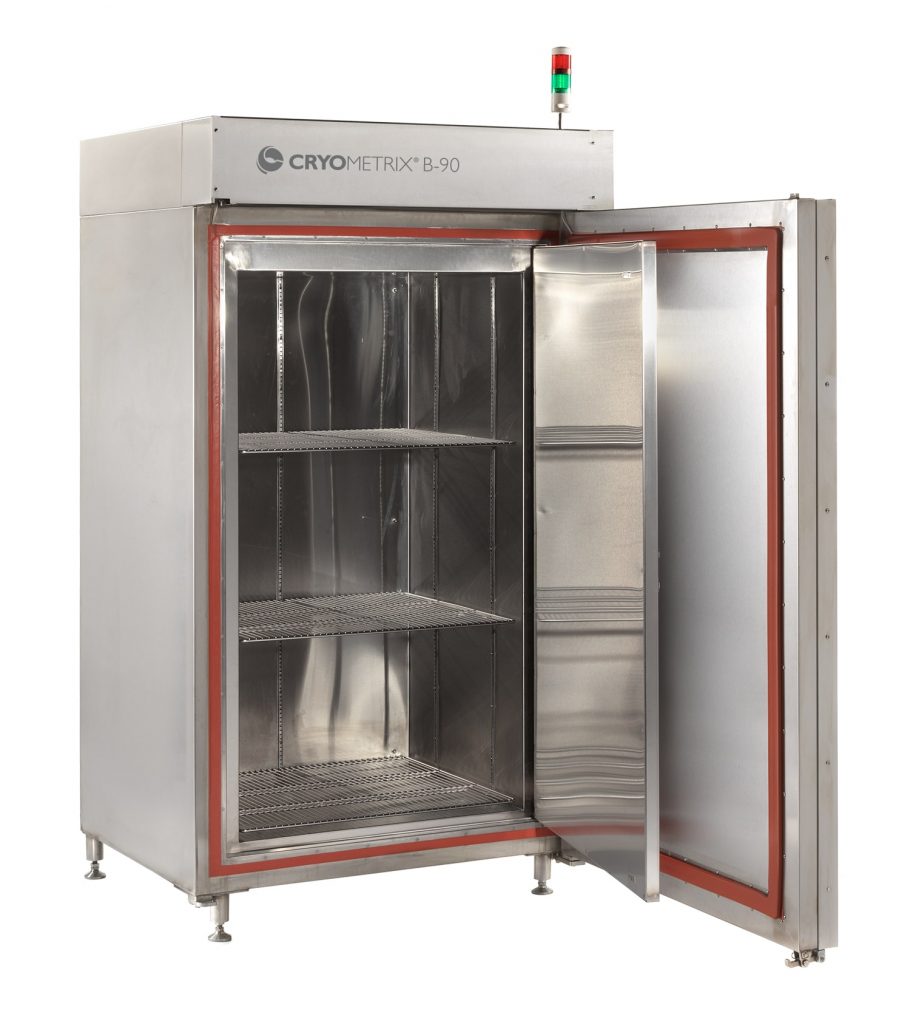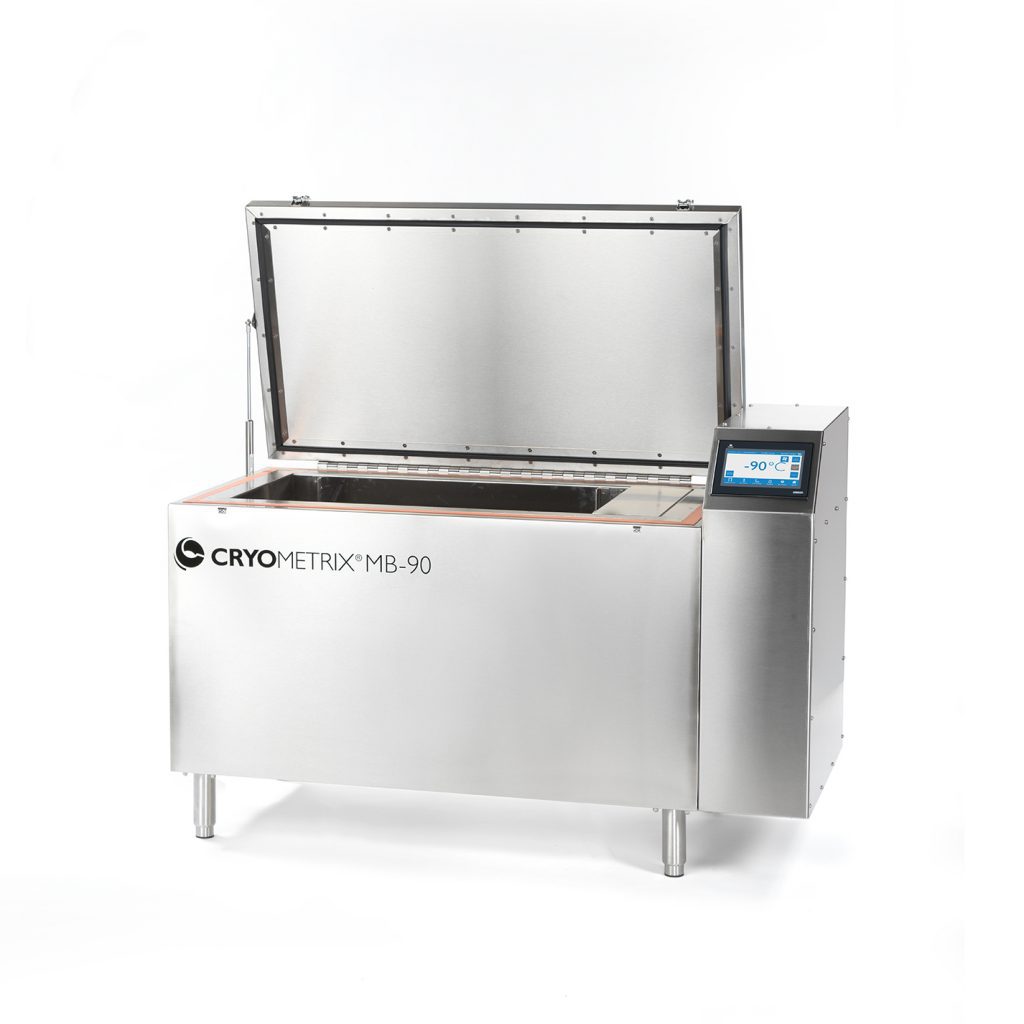The Cryometrix B-90 and MB-90 Blast Freezers offer cutting-edge solutions powered by liquid nitrogen technology. Unlike traditional mechanical freezers, these models rely on a closed liquid nitrogen system that ensures rapid cooling while maintaining safety and energy efficiency. Designed for both industrial-scale operations and smaller laboratories, these freezers provide unmatched speed, sustainability, and user-friendly features, making them the preferred choice across various industries such as pharmaceuticals, biotechnology, and food processing.
B-90 Blast Freezer: High Capacity, Rapid Cooling for Large-Scale Operations
The B-90 Blast Freezer is engineered to deliver the fastest cooling in the industry, capable of reducing temperatures from 20°C to -90°C in just 10 minutes. This level of efficiency is ideal for large-scale operations where throughput and speed are critical. For example, in industrial applications like pharmaceutical production or biotech research, the B-90 can handle high volumes while ensuring uniform cooling and preserving product integrity.
Key Features of the B-90 Blast Freezer:
- Ultra-fast cooling: From ambient to -90°C in 10 minutes, improving productivity by significantly reducing the freezing cycle.
- High capacity: The freezer accommodates up to 48 5L bottles with a total capacity of 700 liters (24.7 cubic feet), making it a perfect solution for large-scale applications.
- Energy-efficient: Using up to 90% less energy than conventional mechanical freezers, the B-90 not only saves on energy costs but also reduces the environmental impact.
- Closed-system nitrogen cooling: Ensures there is no direct contact between the liquid nitrogen and products, providing an additional layer of safety for operators and maintaining the integrity of the stored materials.
- Customizable security: Offers 3 security levels with up to 100 individual users for enhanced access control. For larger operations, the system can be upgraded through an IPC package to allow for more users and additional functionalities.
- Data logging and monitoring: Equipped with integrated data logging software, the B-90 allows for real-time monitoring and easy access to temperature and performance records. These records can be exported in CSV format, providing valuable insights for compliance and operational analysis.
The B-90’s combination of high capacity, rapid cooling, and energy efficiency makes it an excellent choice for industries where speed and precision are essential. Its stainless steel construction ensures durability, and the 20-year warranty on the cooling system offers long-term reliability, further reinforcing its value as a robust, low-maintenance solution.
MB-90 Blast Freezer: Compact and Powerful for Laboratory and Small-Scale Use
For operations requiring a more compact freezer without compromising on efficiency, the MB-90 Blast Freezer is the ideal solution. While smaller in size compared to the B-90, the MB-90 delivers the same powerful liquid nitrogen cooling, reaching -90°C from ambient in just 3 minutes. Its compact footprint and efficiency make it perfect for laboratories, research facilities, and other space-constrained environments.
Key Features of the MB-90 Blast Freezer:
- Compact size: The MB-90 has a space-saving design with a footprint of just 27 in x 56 in, making it easy to integrate into labs or facilities where space is at a premium.
- Rapid cooling: Achieves -90°C in 3 minutes, ensuring quick freezing cycles and reduced waiting times in experiments or smaller-scale production runs.
- Versatile temperature control: The freezer’s temperature can be adjusted between 40°C and -90°C, allowing for highly customizable freezing and thawing processes.
- Data logging and compliance: Like the B-90, the MB-90 features built-in data logging and supports 21 CFR Part 11 compliance, making it a trusted choice for industries that require precise tracking and reporting of temperature data.
- Energy-efficient operation: With 7x lower energy consumption compared to traditional lab freezers, the MB-90 reduces operational costs while delivering high performance.
- Durability and ease of cleaning: Its 100% stainless steel interior and exterior provide long-lasting durability, and the easy-to-clean design minimizes maintenance efforts.
Despite its smaller size, the MB-90 packs a punch with its rapid freezing capabilities, making it an excellent option for laboratories, experimental setups, and small-scale production facilities. Whether used in a research lab or as part of a larger industrial system, the MB-90 offers efficiency, flexibility, and unmatched performance.
Environmental Impact and Compliance
Environmentally Friendly Freezing with Clean Emissions
One of the standout features of Cryometrix blast freezers is their commitment to environmental sustainability. Both the B-90 and MB-90 models emit only nitrogen gas, a naturally occurring element that constitutes over 75% of the Earth’s atmosphere. This ensures that Cryometrix freezers have a minimal impact on the environment compared to mechanical freezers that rely on harmful refrigerants like CFCs or freon.
In addition, the low energy consumption of Cryometrix freezers plays a vital role in reducing the carbon footprint of freezing operations. Using up to 90% less energy than traditional compressor-based systems, these freezers are ideal for businesses looking to lower their energy costs while still maintaining high performance.
Compliance with Industry Standards
Cryometrix blast freezers are designed with compliance in mind, meeting the highest standards for safety and operational efficiency. Both models are compliant with UL 508a and CE standards, ensuring they meet the requirements for electrical safety and environmental protection. For industries such as pharmaceuticals and biotechnology, where regulatory compliance is critical, Cryometrix offers an optional FDA 21 CFR Part 11 compliance package to ensure that all data logging and temperature tracking meet regulatory standards.
Long-Term Reliability with a 20-Year Warranty
Cryometrix offers a 20-year warranty on the cooling systems of both the B-90 and MB-90 freezers. This long-term coverage highlights the durability and reliability of Cryometrix’s innovative liquid nitrogen technology, providing peace of mind for businesses that rely on consistent, high-performance freezing capabilities. The stainless steel construction of these freezers further enhances their durability, making them a low-maintenance solution that reduces the need for frequent repairs or servicing.
Why Choose Cryometrix Blast Freezers?
Speed and Efficiency for High-Volume Freezing
When it comes to blast freezing, speed and efficiency are crucial. The Cryometrix B-90 and MB-90 Blast Freezers lead the industry in rapid cooling times, with the B-90 capable of achieving -90°C in just 10 minutes and the MB-90 reaching the same temperature in 3 minutes. This dramatic reduction in freezing time improves productivity and reduces bottlenecks in production or laboratory workflows, allowing businesses to operate more efficiently and effectively.
Energy Efficiency and Cost Savings
By using liquid nitrogen cooling instead of traditional compressor-based systems, Cryometrix freezers drastically reduce energy consumption. Both models consume 7x less electricity than comparable freezers, lowering operational costs and reducing the environmental impact of freezing processes. Additionally, these freezers do not require energy-intensive HVAC systems, further decreasing overall energy use and operational expenses.
Versatility for a Range of Applications
Cryometrix blast freezers are designed to accommodate a wide variety of freezing needs. From large-scale industrial operations that require high capacity and throughput to smaller laboratories that need precise temperature control and flexibility, the B-90 and MB-90 freezers can handle it all. The ability to easily adjust temperature profiles and track performance through integrated data logging makes them suitable for applications across diverse industries.
Try Cryometrix Blast Freezers for Yourself
Discover the unmatched performance and efficiency of Cryometrix blast freezers by scheduling a demo or experimental test run. Our team will work with you to design a freezing process tailored to your specific needs, ensuring optimal productivity and performance. Whether you need the high capacity and rapid cooling of the B-90 or the compact efficiency of the MB-90, Cryometrix has the solution for you.
Contact us today to learn more about how Cryometrix blast freezers can revolutionize your freezing processes.




